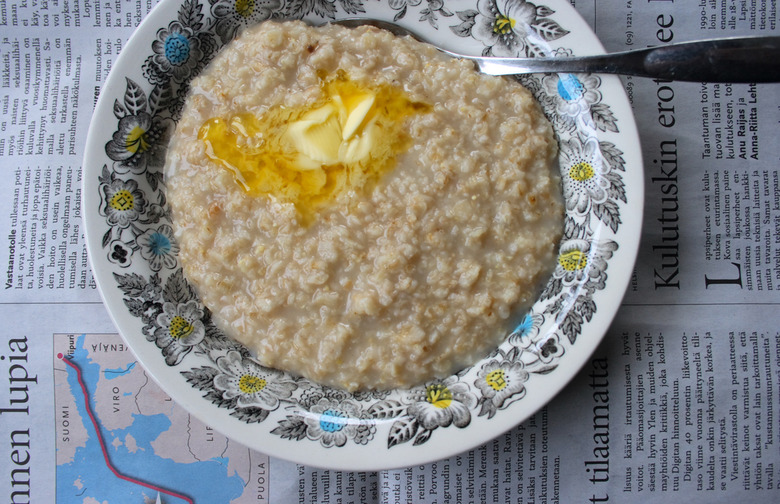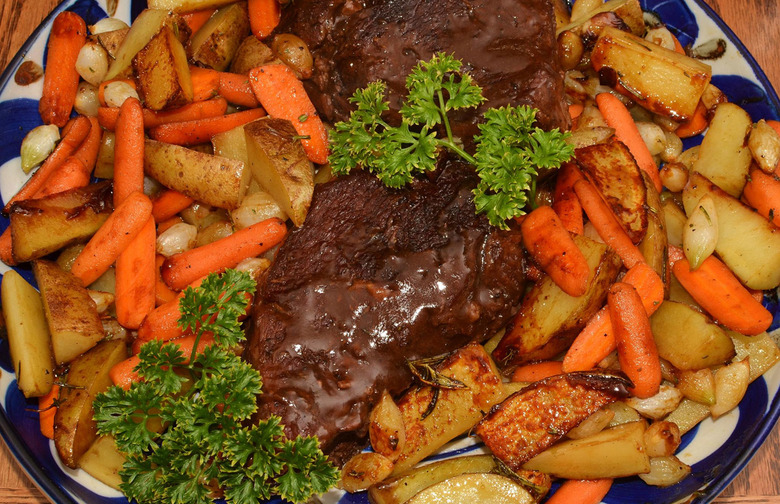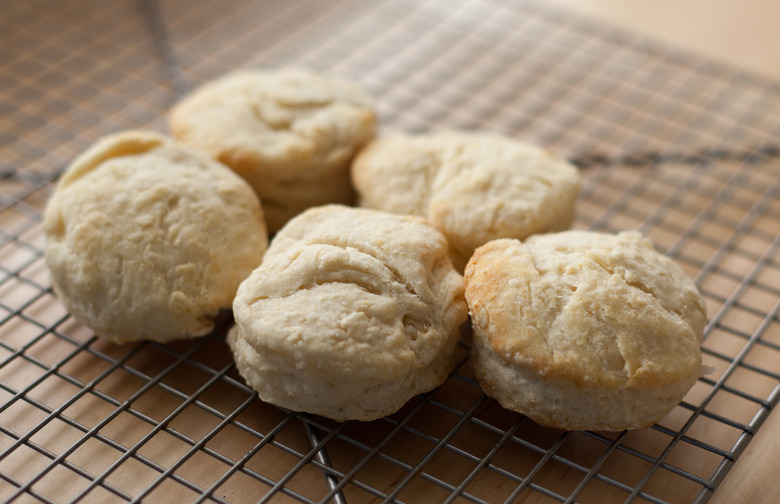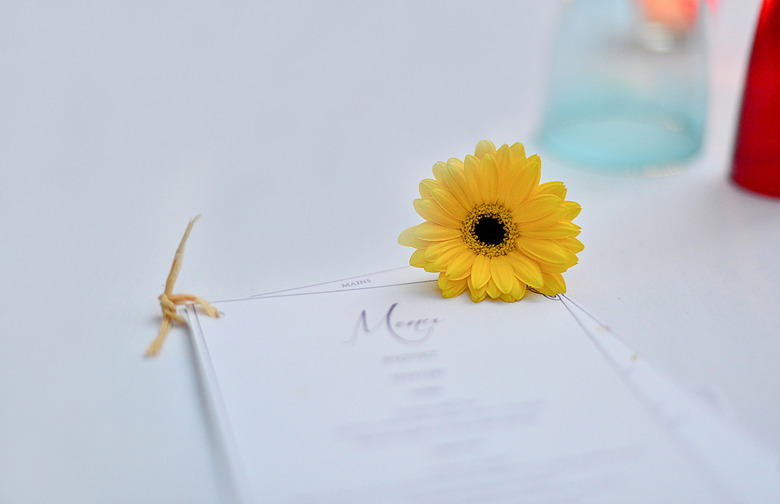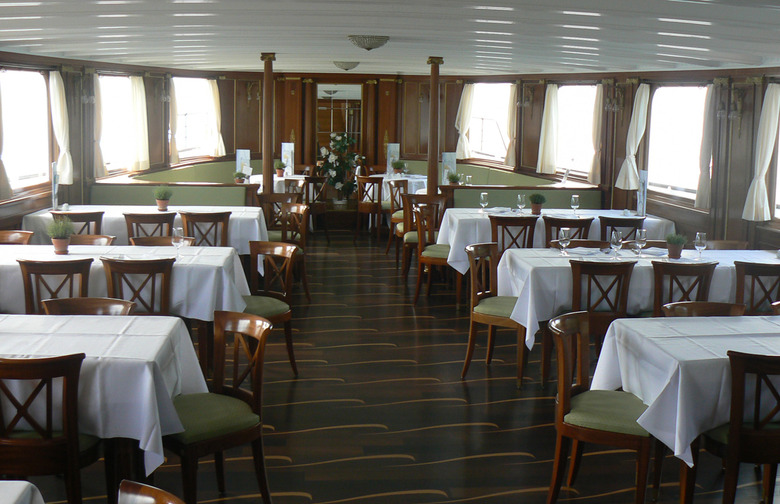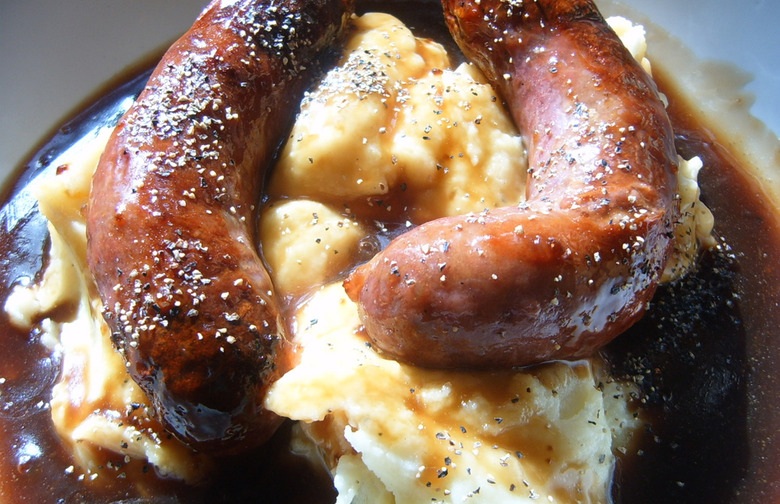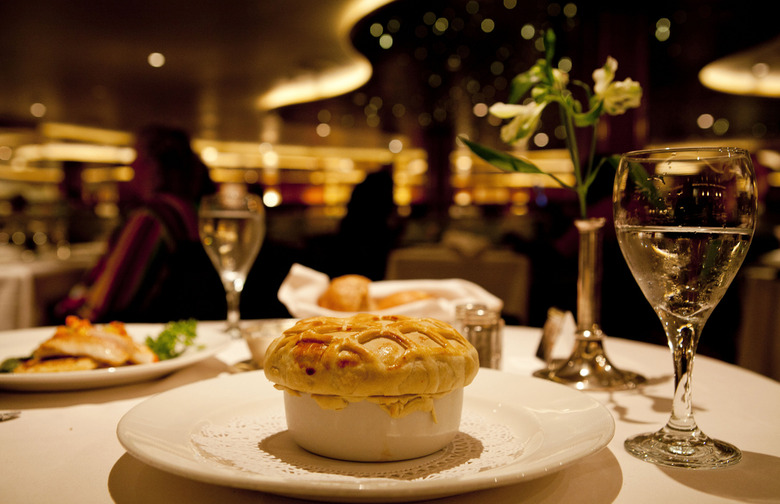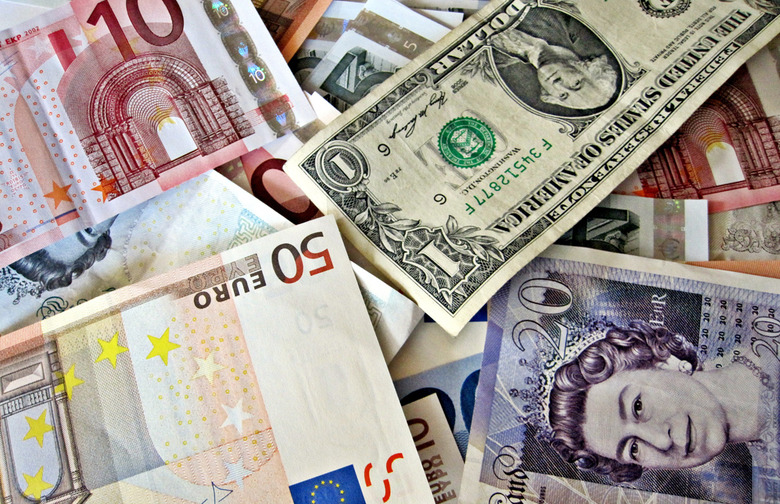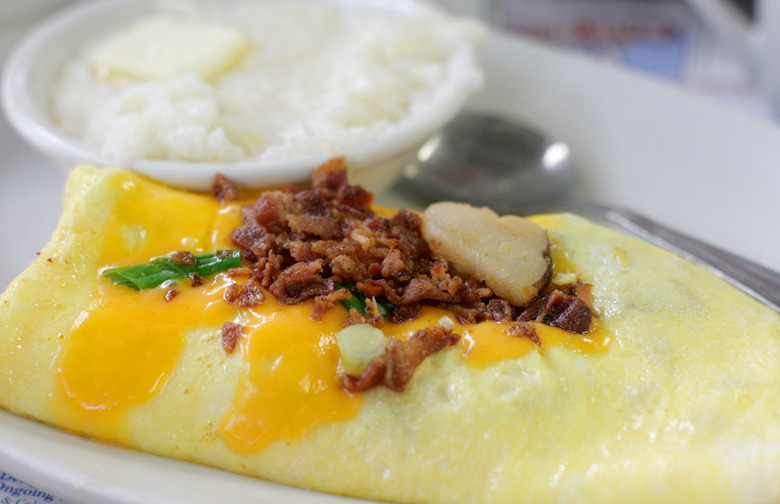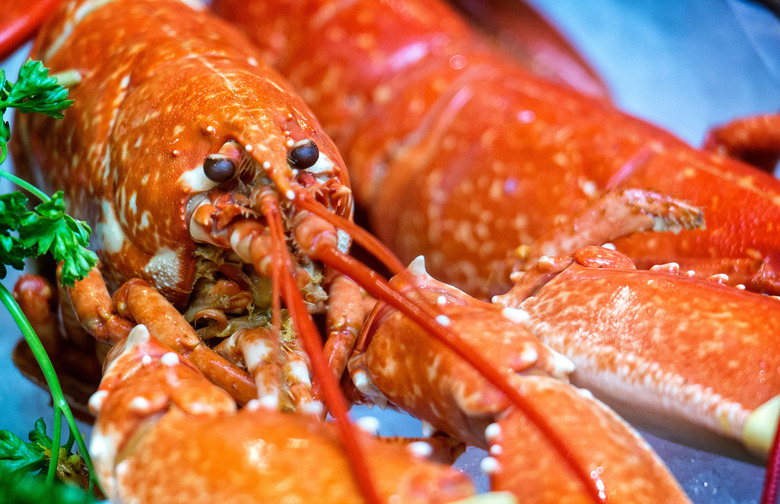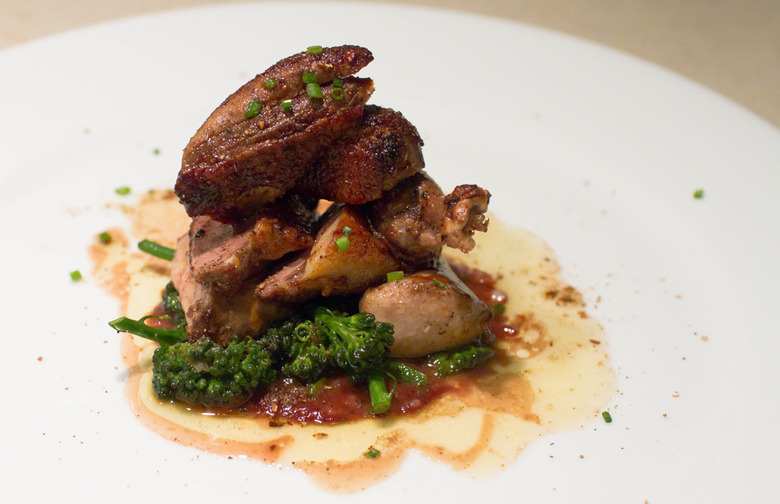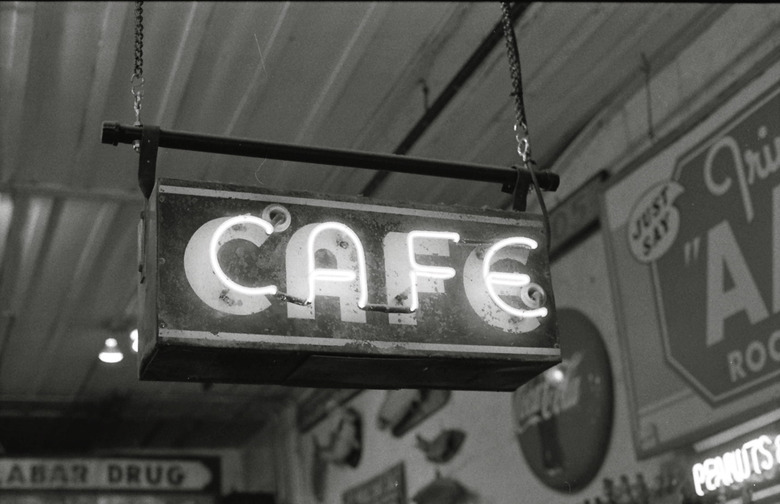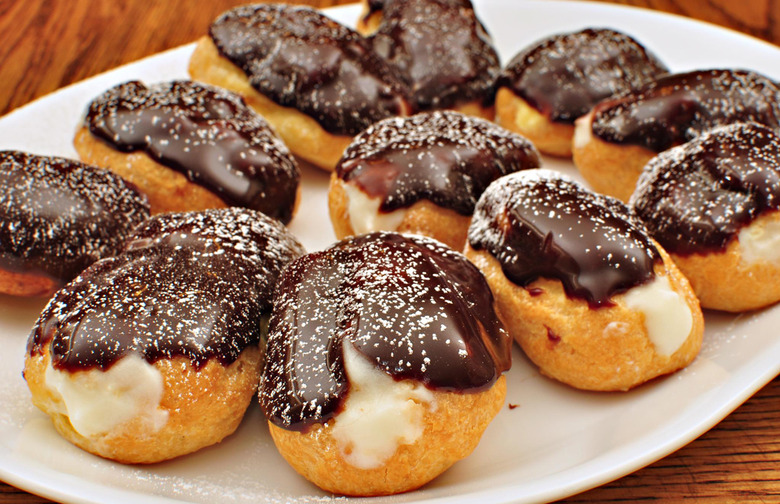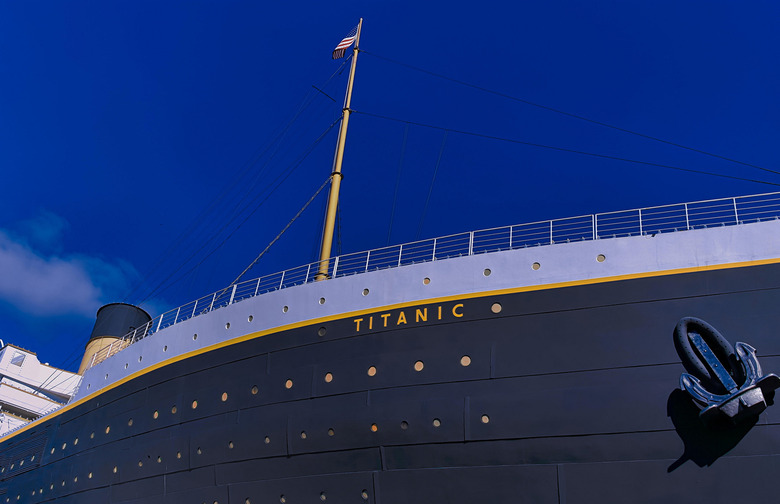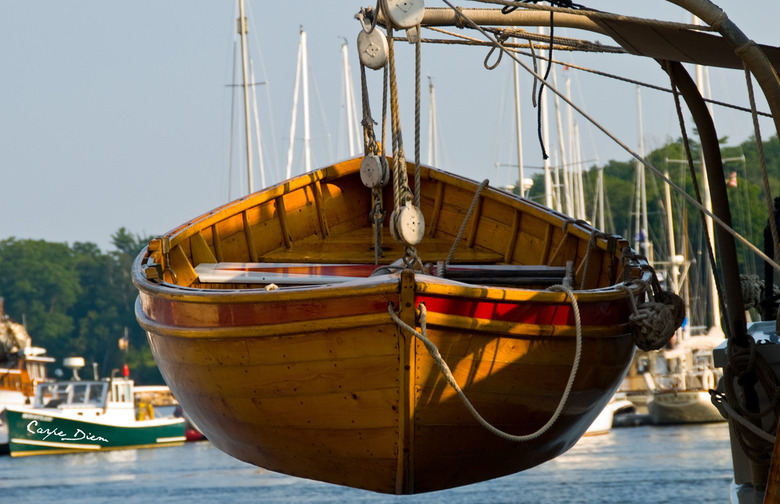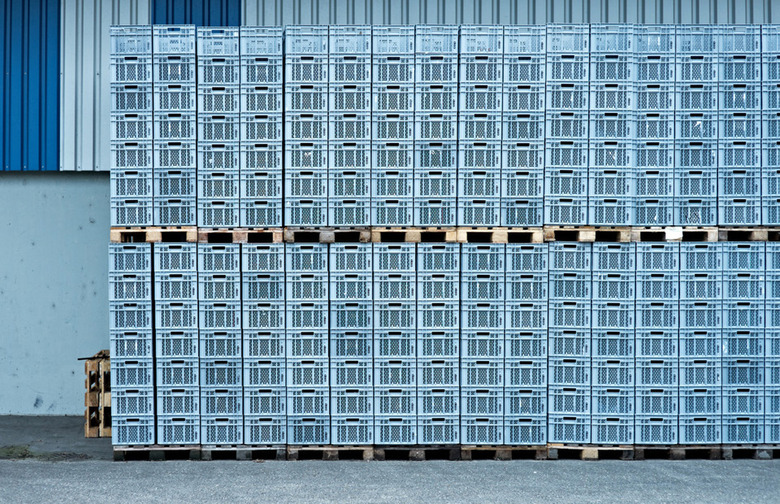Last Meal: Here's What People Ate And Drank On The Titanic (Slideshow)
Most of the information available regarding third class meals come from menus recovered from the wreckage, which are now on display in museums. In addition to listing the daily offerings, the third class menus also contained a disclaimer stating, "Any complaint respecting the food supplied, want of attention or incivility, should be at once reported to the Purser of Chief Steward. For purposes of identification, each Steward wears a numbered badge on the arm." Curiously, this note only appears on the third class menu.
Third Class — Dining Saloon
Folks in the third class dined on the middle (F) deck, at long tables that could seat about 20 each, 473 in total. Since there were 710 passengers in third class, a second seating was necessary to accommodate everyone. The dining room was sparsely decorated, but portholes, sidelights, and an enamel-white paint job brightened up the room and made it appear larger. Hats, coats, and scarves could be hung on hooks attached to the walls.
Third Class — Breakfast
Those staying in the lowest class onboard weren't simply fed the crumbs of the rich, but actually had decent meals put together (the Titanic was a luxury cruise liner, after all). To start the day, something light like oatmeal porridge was served, along with smoked herring and jacket (i.e., baked) potatoes, ham and eggs, fresh bread and butter (or marmalade), Swedish bread, and tea and coffee to drink.
Third Class — Dinner
Dinner was the midday meal in third class, followed by tea and an evening supper. Dinner consisted of a starter such as rice soup and fresh bread, followed by a main course. On the ship's last day, April 14, roast beef with brown gravy was the selection, with sides of sweet corn and boiled potatoes. Dessert was included as the last part of dinner as well, with offerings like plum pudding with sweet sauce, and fruit.
Third Class — Tea
Even in third class, tea service was offered each day. (A lot of the passengers were British after all.) In addition to a hot beverage, teatime eats included a variety of cheese, pickles, fresh bread and butter, and stewed figs and rice.
Third Class — Supper
At the end of the day, supper was served in third class, and the menu options look a lot more like most people would expect from a steerage supper. Gruel (a thin porridge made of cereal — oat, wheat, rye, or rice — boiled in water or milk) was the April 14 option, along with cabin biscuits and cheese.
Third Class — Cabin Biscuits
What the heck is a cabin biscuit anyway? More like a cracker, cabin biscuits were a simple bread staple made with flour, shortening, water, and a bit of salt. They were used to help settle passengers' stomachs, which was especially important for those down in third class, as seasickness was more prevalent in steerage accommodations.
Second Class — Menus
Interestingly, there are only two authentic Titanic second class menus still in existence today. The first, the breakfast menu from April 11, only survived because second class steward Jacob Gibbons used it as a post card, which he mailed during a stop in Ireland on the same day. Eerily, he had written, "Good voyage up to now" on the back of it.
Second Class — Dining Room
Unlike in third class, the second class dining room could comfortably fit all 564 passengers in a single seating. Located on the "D" deck, the elegant dining room had long tables with crimson leather swivels chairs (bolted to the floor, in case of bad weather), oak paneling, linoleum tiling, and a piano in the center.
Second Class — Breakfast
In contrast to the practice in third class, where only one menu was released each day containing all of the meals served, the second and first classes had a different menu for each sitting. For breakfast, according to an April 11 menu, fruit, rolled oats, and boiled hominy was served along with a large range of options that included fresh fish, Yarmouth bloaters (herring), grilled ox kidneys and bacon, American dry hash au gratin, grilled sausage and mashed potatoes, grilled ham and fried eggs, and fried potatoes. For bread, Vienna rolls (also called Kaiser rolls) and graham rolls, soda scones, and buckwheat cakes with maple syrup were offered, as was conserve, marmalade, watercress, and coffee and tea.
Second Class — Dinner
According to an April 14 menu, there were plenty of delicious dinner options available in the second class. Consommé and tapioca were the starters, followed by baked haddock in sharp sauce, curried chicken and rice, spring lamb with mint sauce, or roast turkey and cranberry sauce. The sides consisted of green peas, puréed turnips, boiled rice, or boiled and roast potatoes, and dessert was plum pudding, wine jelly, coconut sandwiches, American ice cream, assorted nuts, fresh fruit, cheese, biscuits, and coffee.
First Class — Dining Room
The Jacobean-style, linoleum-tiled (with a pattern that resembled a Persian carpet) first class dining room was capable of holding 500 people. Unlike the long tables in the other two dining rooms, this one had small tables, which made for easier conversations between passengers. Like the second class dining room, this one was located on the "D" deck, but was also situated between the second and third funnels, where the ride was supposed to be the smoothest of anywhere on the Titanic.
First Class — Menus
By far, the most menus to survive the Titanic's voyage came from first class — mainly because the most passengers to survive came from that class (as opposed to the third, for instance, where 93 percent of the men perished). Some have been recently sold at auction, with the last day's lunch menu fetching £76,000 ($107,500) back in 2012. The menu from the first day's lunch cost almost as much ($102,000). One of the 10-course café menus (of which there are numerous surviving copies) brought in $88,000 at auction.
First Class — Breakfast
Welcome to first class, where passengers receive the best food and the largest selections, as evidence by the surviving menus. On April 11, the selection included baked apples, fresh fruit, stewed prunes, Quaker (name brand!) oats, boiled hominy, puffed rice, fresh herring, Finnan haddock, smoked salmon, grilled mutton kidneys and bacon, grilled ham, grilled sausage, lamb collops, vegetable stew, eggs (fried, shirred, poached, or boiled), plain and tomato omelettes to order, sirloin steak and mutton chops to order, potatoes (mashed, sautéed, or jacket), cold meat, Vienna and graham rolls, soda and sultan scones, corn bread, buckwheat cakes, black currant conserve, Narbonne honey, Oxford marmalade, and watercress.
First Class — Lunch
In first class, there were three parts to the lunch service: the luncheon, food from the grill, and a buffet. For the first, consommé jardinière or fermier was served, along with a rotating group of options that include hodge-podge, cock-a-leekie (Scottish leek and chicken stock soup), fillets of plaice or brill, beef steak and kidney pie, roast surrey capon, egg à l'Argenteuil, chicken à la Maryland, corned beef, vegetables, and dumplings. Grill options featured mutton chops, potatoes (mashed, fried, or baked jacket), and custard pudding, rice pudding, apples Manhattan, apple meringue, and pastries for dessert. Even the buffet selections were fancy, with the menu containing anything from seafood like fresh lobster, potted shrimp, soused herring, salmon, sardines, and anchovies, to meats like roast beef, round of spiced beef, Virginia and Cumberland ham, Bologna sausage, brawn, galantine of chicken, and corned ox tongue. Various imported cheeses were also available, as was "iced draught Munich Lager beer."
First Class — Dinner
Of course, the best offerings were saved for dinner. In first class, one could expect only the finest dishes, such as the ones found on April 14 dinner menu. It included various hors d'oeuvres, oysters, consommé Olga, cream of barley soup, salmon with mousseline sauce and cucumber, filet mignons Lili, sauté of chicken lyonnais, vegetable marrow farcie, lamb with mint sauce, roast duckling and apple sauce, sirloin of beef, château potatoes, green peas, creamed carrots, boiled rice, boiled new potatoes, punch Romaine, roast squab and cress, cold asparagus vinaigrette, pâté de foie gras, celery, Waldorf pudding, peaches in chartreuse jelly, chocolate and vanilla éclairs, and French ice cream (as opposed to the American variety served in second class).
First Class — Café
As if the lavish first class dining room wasn't enough already, passengers of this standing could also eat in the Café Parisien — nicknamed "The Ritz" — which featured an à la carte menu and large picture windows and was located just off the main first class dining room. This marked the first time ever that diners on a British ship could eat with a view of the ocean.
First Class — Final Feast
The most impressive meal of the entire trip was served in the first class café on the last day. I'll spare you the entire list, because it contains a whopping 10 courses, but it basically included the best of all the previous dinner options in first class, with an addition or two. Additionally, not only were the first class dining rooms exclusive to only those passengers, even the 10-course menu was marked in large, bold print as "PRIVATE."
Main Dining Room – The Man Behind It All
The owner and manager of both first class eateries was Gaspare Antonio Pietro Gatti, aka "Luigi," an Italian immigrant to England and respected London restauranteur. He had his own staff of chefs, waiters, and kitchen workers whom he paid out of his own pocket, and were not employees of White Star Line. Gatti went down with the ship, as did 63 of his 66 staff members.
Lifeboat Rations
It's not certain whether these were also available on the ship, but Spillers & Bakers Pilot Crackers were handed out as rations to passengers on the ship's lifeboats. Food, of course, had to be available to those fleeing any major aquatic disaster, as there's no telling when they might be rescued. This is especially true for the Titanic, since it was on a transatlantic journey, and lifeboats could end up being adrift for days.
The Famous Cracker
James Fenwick, a traveler on the RMS Carpathia (the cruise liner that picked up some of the Titanic's survivors) got his hands on one of the cracker rations, and kept it in an envelope labeled, "Pilot biscuit from Titanic lifeboat April 1912." Still in remarkably good condition, the cracker sold at an auction in October 2015 for £15,000, or about $21,000.
Total Provisions
All in all, according to TitanicFacts.com, the ship carried 14,000 gallons of water for every 24 hours of sailing, 75,000 pounds of fresh meat (including 25,000 pounds of poultry, 7,500 pounds of ham and bacon, and 2,500 pounds of sausage), 11,000 pounds of fresh fish, 4,000 pounds of salted and dried fish, 36,000 apples, 36,000 oranges, 16,000 lemons, 13,000 grapefruits, 10,000 pounds of dried rice and beans, 7,000 heads of lettuce, 3,500 pounds of onions, 3,500 pounds of tomatoes, 2,500 pounds of green peas, 800 asparagus bundles, 40 tons (tons!) or potatoes, 250 barrels of flour, 10,000 pounds of cereal, 10,000 pounds of sugar, 2,200 pounds of coffee, 1,120 pounds of marmalade and jam, 1,000 loaves of bread, 800 pounds of tea, 40,000 fresh eggs, 6,000 pounds of butter, 1,500 gallons of fresh milk, 600 gallons of condensed milk, and 1,200 quarts of ice cream. For alcohol, there were 15,000 bottles of ale, 1,000 bottles of wine, and 850 bottles of liquor. A whopping 8,000 cigars were on board as well.

